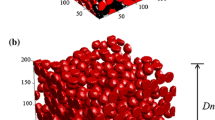Abstract
The anodes used in SOFCs are composites, formed by a mixture of nickel and YSZ particles. This paper presents a model for this type of electrode, taking mass transport effects into account. The effect of the operating conditions, such as temperature and pressure, is discussed. Also, the effect of the choice of the geometrical parameters, such as electrode thickness and particle radius, on the electrode performance is analysed in detail. In particular, the electrode losses display a minimum for a well-defined radius of the electrode particles, which is related to a trade-off between activation and concentration losses.












Similar content being viewed by others
Abbreviations
- A :
-
Active area per unit volume (cm2 cm−3)
- D :
-
Diffusivity (cm2 s−1)
- F :
-
Faraday’s constant (96,487 C mol−1)
- I :
-
Overall electrode current density (A cm−2)
- i :
-
Current density in the electrode (A cm−2)
- i 0 :
-
Exchange current density (A cm−2)
- i n :
-
Transfer current density per unit of active area (A cm−2)
- N :
-
Molar flux of the component i (mol cm−2 s−1)
- p i :
-
Partial pressure of i component (atm)
- p ref :
-
Reference pressure (atm)
- P :
-
Particle dimension ratio (r io/r el)
- r :
-
Particle radius (cm)
- R :
-
Universal gas constant (J mol−1 K−1)
- r pore :
-
Mean pore radius (cm)
- t :
-
Overall electrode thickness (cm)
- T :
-
Temperature (K)
- V :
-
Electric potential (V)
- x :
-
Main co-ordinate (cm)
- x i :
-
Molar fraction (of i component) (−)
- β:
-
Transfer coefficient
- γ:
-
Pre-exponential factor (Eq. 8)
- ε:
-
Porosity
- η:
-
Overpotential (V)
- ρ:
-
Resistivity (ohm m)
- σ:
-
Collision diameter (A)
- τ:
-
Tortuosity
- φ:
-
Volumetric fraction of electronic conductor
- Ω:
-
Collision integral
- el:
-
Electronic conductor
- io:
-
Ionic conductor
- K :
-
Knudsen
- 0:
-
inlet
- eff:
-
effective
References
Fuel Cell Handbook (2000) E.G. and G. Services Parsons Inc
Singhal C, Kendall K (2003) High temperature solid oxide fuel cells, fundamentals, design and applications. Elsevier, Amsterdam
Cannarozzo M (2005) Degree thesis. Effects of mass transport on the performance of composite electrodes for SOFC applications. DICHEP, University of Genoa, Genoa
Costamagna P, Costa P, Antonucci V (1998) Electrochim Acta 43(3–4):375–394
Cannarozzo M, Grosso S, Agnew G, Del Borghi A, Costamagna P (2007) J Fuel Cell Sci Technol 4(1):99–106
Costamagna P, Costa P, Arato E (1998) Electrochim Acta 43(8):967–972
Kenjo T, Osawa S, Fujikawa K (1991) J Electrochem Soc 138(2):349–355
Sunde S (1996) J Electrochem Soc 143(3):1123–1132
Abel J, Kornyshev AA, Lehnert W (1997) J Electrochem Soc 144(12):4253–4259
Bird RB, Stewart WE, Lightfoot EN (1960) Transport phenomena. Wiley, New York
Mason EA, Malinauskas AP (1983) Gas transport in porous media: the dusty-gas model. Elsevier
Krishna R, Wesselingh JA (2000) Mass transfer in multicomponent mixture. Delft University Press
Costamagna P, Honegger K (1991) J Electrochem Soc 138(2):349–355
Bossel UG (1992) Facts and figures. Final report on SOFC data, IEA report. Operating Task II, Swiss Federal Office of Energy, Berne
Costamagna P, Costa P, Arato E (1998) Electrochim Acta 43(8):967–972
Acknowledgements
The authors thank Rolls-Royce Fuel Cell Systems Ltd and the European Union (European Contracts NNE5-2001-791 PIP-SOFC and SES6-CT-2003-502612 REAL-SOFC) for financial support during this work. Also, the authors acknowledge the British Council/CRUI project for funding an exchange of visits between Rolls-Royce Fuel Cell Systems Ltd and the University of Genoa.
Author information
Authors and Affiliations
Corresponding author
Rights and permissions
About this article
Cite this article
Cannarozzo, M., Borghi, A.D. & Costamagna, P. Simulation of mass transport in SOFC composite electrodes. J Appl Electrochem 38, 1011–1018 (2008). https://doi.org/10.1007/s10800-008-9527-1
Received:
Revised:
Accepted:
Published:
Issue Date:
DOI: https://doi.org/10.1007/s10800-008-9527-1




